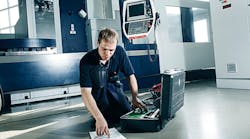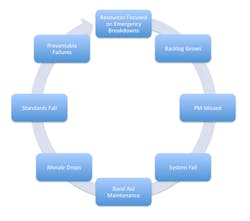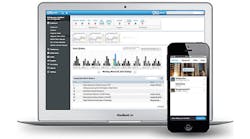According to manufacturing engineering experts, to achieve best-in-class maintenance standards, 85% of all machine maintenance activities should be planned in advance. By planning maintenance, operators can circumvent breakdowns or in many cases, identify the major issues before they turn into something more serious. Planned maintenance also gives technicians time to prepare the right tools and parts for the job.
On the other hand, reactive repairs take longer to resolve, as technicians don’t have the correct parts, manuals or schematics prepared. Also, reactive maintenance won’t keep keep systems running in optimal “as new” condition and over time, systems deteriorate faster so don’t maximize their initial capital cost investment. Equipment failures can be unpredictable but relying on reactive maintenance means you will experience increasingly more emergency breakdowns.
If reactive maintenance costs more than planned, it defies logic why more reactive maintenance than planned maintenance is performed in North America. Reactive maintenance also makes it difficult to keep your maintenance budget under control and leveled out throughout the year.
Why is reactive maintenance a big part of the culture? One of the reasons for this is that organizations get caught up in “the vicious cycle of maintenance,” which instills a reactive understanding of maintenance in the organization. If this is allowed to establish itself, it can set in motion a downward spiral to zero planned maintenance. Here it is:
Picture the scenario. A planned maintenance schedule is put in place to keep production running. When PM’s are postponed or skipped completely, the assets start to deteriorate. As a result, emergency breakdowns become more common leading to quick, “Band-Aid” maintenance, and further missed PMs.
Very soon, the maintenance team spends more and more time performing reactive maintenance on assets that are now in a very poor condition. When asked about PMs or entering repair data into the CMMS, the common response is “we don’t have time to do that.” They have transitioned from fire preventers to fire fighters. Now, their sole job is to fix things when they break.
If you do not spot the trend early enough, your organization will quickly fall into the cycle. Production managers, maintenance supervisors and technicians can be so entrenched in the reactive way of doing maintenance that may not realize that they are caught up in this cycle. They are in it so long that it has become a way of life.
Don't React. Meet the Schedule.
In many organizations, maintenance is viewed as a cost center, so the argument in favor of performing more planned maintenance may not make sense. However, by performing planned maintenance, you will reduce reactive maintenance caused by emergency breakdowns, leading to a corresponding reduction in maintenance costs. In order to break the vicious cycle and progress toward maintenance reliability excellence, follow these six steps:
1. Get agreement and by in from the entire team. All relevant stakeholders in the organization need to recognize the issues and agree that change is needed or the project is doomed to fail.
2. Measure your current planned maintenance percentage. This will determine the starting baseline. The easiest way to do so is in the reports section of your CMMS software.
3. Set the goals. when the team is committed to change and agree on the goals, everyone is accountable to achieve those goals.
4. Develop a plan to achieve those goals. The team collectively needs to put a strategy in place to meet the agreed reliability, availability and cost goals. By analyzing past equipment failures in their CMMS, they can quickly identify repeat issues, assets in a poor condition, unreliable parts, reoccurring failure modes etc. They can then put a plan in place to address these issues systematically. Part of the plan could be to dedicate a number of technicians exclusively to planned maintenance on critical assets. That way, they make an immediate dent in planned maintenance percentage.
5. Ensure the KPIs are in place to measure against those goals - Key metrics such as planned maintenance percentage mean time between failure, and PM compliance should be captured, recorded and trended. Continually tracking your KPI’s throughout the improvement process can help determine whether the process changes added value or reduced cost. A CMMS is an inexpensive, but incredibly useful tool to track and analyze your maintenance activities and corresponding KPI’s and metrics.
6. Strive for continuous improvement. Following the plan items in step 4 may take you so far so the team must continually strive to identify ways of improving the process and reaching those goals quicker and more efficiently. For example, ongoing training will help technicians refine and improve work process which in turn will increase system availability and reduce costs.
Breaking the cycle can be difficult but remember the old adage, prevention is better than cure. Best in class maintenance calls for ~85% planned maintenance as relying on reactive maintenance is like flying blind with no end in sight. Emergency repairs make it impossible to forecast budgets and plan proactive equipment replacements. By performing the recommended amount of planned maintenance at your plant, you will reduce emergency repairs and associated costs. If reactive maintenance has become a way of life at your organization, follow the 6 steps outlined above and break out of the vicious cycle of maintenance.










